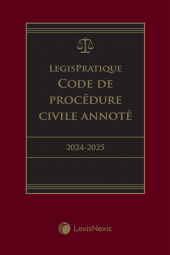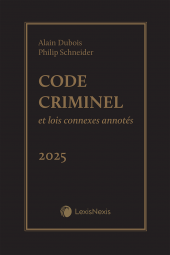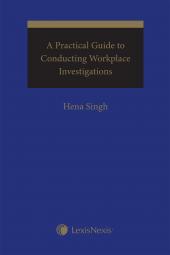A Practical Guide to Conducting Workplace Investigations
One Year Subscription Only Terms
Subscribers receive the product(s) listed on the Order Form and any Updates made available during the annual subscription period. Shipping and handling fees are not included in the annual price.
Subscribers are advised of the number of Updates that were made to the particular publication the prior year. The number of Updates may vary due to developments in the law and other publishing issues, but subscribers may use this as a rough estimate of future shipments. Subscribers may call Customer Support at 800-833-9844 for additional information.
Subscribers may cancel this subscription by: calling Customer Support at 800-833-9844; emailing customer.support@lexisnexis.com; or returning the invoice marked 'CANCEL'.
If subscribers cancel within 30 days after the product is ordered or received and return the product at their expense, then they will receive a full credit of the price for the annual subscription.
If subscribers cancel between 31 and 60 days after the invoice date and return the product at their expense, then they will receive a 5/6th credit of the price for the annual subscription. No credit will be given for cancellations more than 60 days after the invoice date. To receive any credit, subscriber must return all product(s) shipped during the year at their expense within the applicable cancellation period listed above.
Détails des produits
As author Hena Singh explains in A Practical Guide to Conducting Workplace Investigations, significant changes in Canadian legislation over the past couple of decades “have led to the requirement that employers conduct or retain someone to conduct internal workplace investigations when there are serious issues which the employer cannot resolve.” It is precisely that requirement that makes this text such a valuable resource.
Respected insight
Written by an experienced employment lawyer who has conducted hundreds of workplace investigations, this text is both authoritative and practical. It provides employment lawyers, litigators, in-house counsel and human resource professionals with a comprehensive guide for dealing with the most common elements of workplace investigations. In addition to including general principles and best practices related to the topic, this book offers process guidance, report writing guidelines, a discussion of seminal case law, and a review of common stumbling blocks and questions.
A number of features in A Practical Guide to Conducting Workplace Investigations will benefit readers:
- Broad coverage of the subject matter, written in plain language, makes it accessible to both legal and non-legal professionals
- Practical support that includes guidelines for report writing as well as a sample investigation report to use as a precedent
- The expertise of an author who is certified in conducting workplace investigations and has extensive experience in the area
This comprehensive volume would be useful for:
- Employment lawyers who need an up-to-date resource on workplace investigations
- In-house counsel who require a reference manual for issues that employers regularly face when going through an investigation
- HR professionals who can rely on its content when retaining counsel for an investigation
Table des matières
Chapter 1: Why and when are investigations necessary?
1. Why are investigations necessary?
2. When are investigations necessary?
3. When investigations are not necessary
Chapter 2: First steps
1. Determine the mandate
2. Understanding relevant definitions
3. Privilege
Chapter 3: Sample fact scenario
1. Background information
2. Written complaint
3. The policy
4. The mandate
Chapter 4: Preliminary considerations before starting a workplace investigation
1. Fact gathering
2. Selecting the investigator
3. Interim measures
4. Timing and location of investigation interviews
5. Contacting the complainant, respondent and witnesses
6. Note-takers and their roles
7. Unionized employees
8. Support people and lawyers
Chapter 5: Interview process
1. Preparing questions in advance
2. Proper note-taking
3. How to open the interview
4. Background information
5. Closing the interview
6. The interviewee sign-off
Chapter 6: Interview techniques
1. Workplace investigation techniques as compared to other types of investigations
2. Interviewing techniques
Chapter 7: The complainant’s interview
1. Complainant interview notes
2. Next steps following complainant interview
Chapter 8: The respondent interview
1. The particulars of the allegations
2. The respondent interview
3. Next steps following respondent interview
Chapter 9: The witness interviews
1. Witness interview: Tony Troy
2. Witness interview: Jessica Jacob
Chapter 10: Decision making
1. Standard of proof
2. Credibility assessments
3. Assessing weight to be given to evidence
Chapter 11: Investigations gone wrong
1. Common errors and how to avoid them
2. Workplace investigations gone wrong: Real cases
Chapter 12: Report writing
1. Introduction to report writing
2. Framework of the investigation report
3. Additional considerations
4. Problems which may arise
Chapter 13: Final steps, final words
Appendix A: Sample workplace investigation report
Produits liés
-
 LegisPratique – Code de procédure civile annoté 2024-2025Date de sortie: September 30, 2024140,00 $
LegisPratique – Code de procédure civile annoté 2024-2025Date de sortie: September 30, 2024140,00 $ -
 Le droit linguistique au Québec, 2e éditionDate de sortie: September 09, 2024155,00 $
Le droit linguistique au Québec, 2e éditionDate de sortie: September 09, 2024155,00 $ -
 Code criminel et lois connexes annotés, édition 2025 (Volume 1) + Guide du praticien (Volume 2) + Livre électroniqueDate de sortie: August 13, 2024175,00 $
Code criminel et lois connexes annotés, édition 2025 (Volume 1) + Guide du praticien (Volume 2) + Livre électroniqueDate de sortie: August 13, 2024175,00 $
 Lexis Nexis
Lexis Nexis 